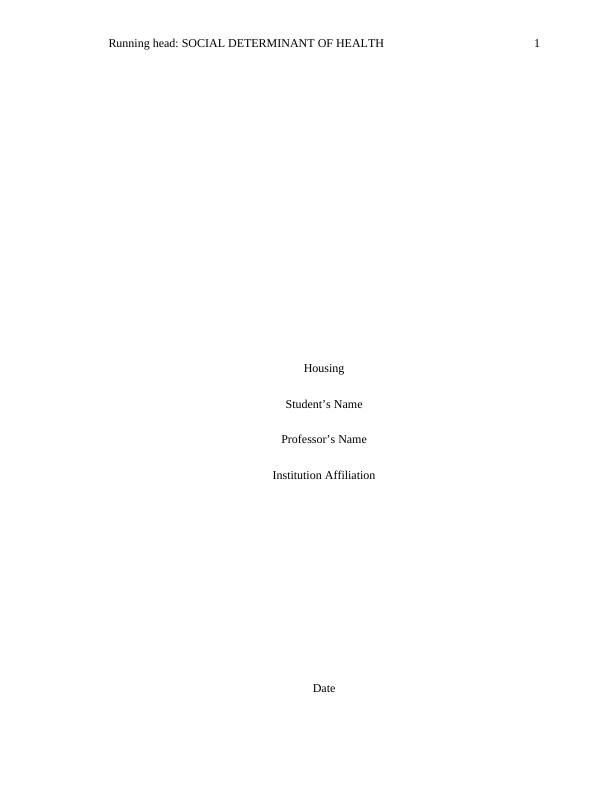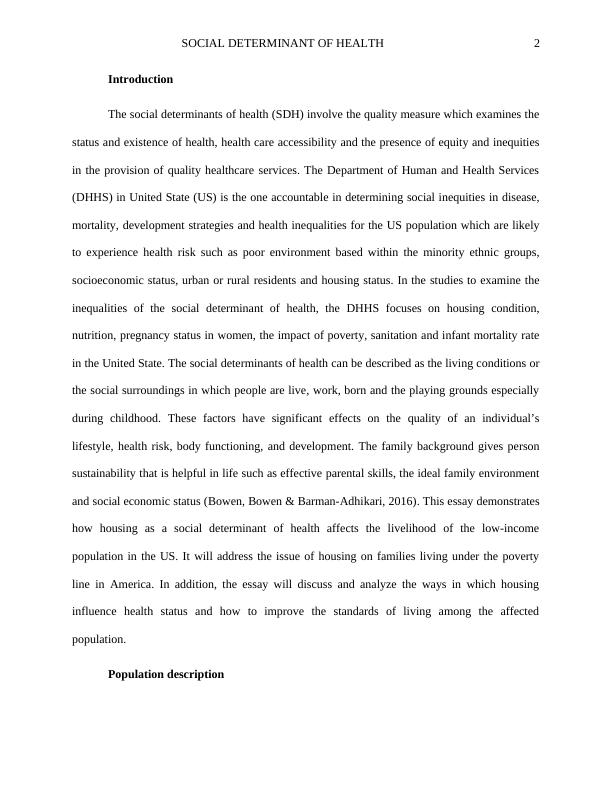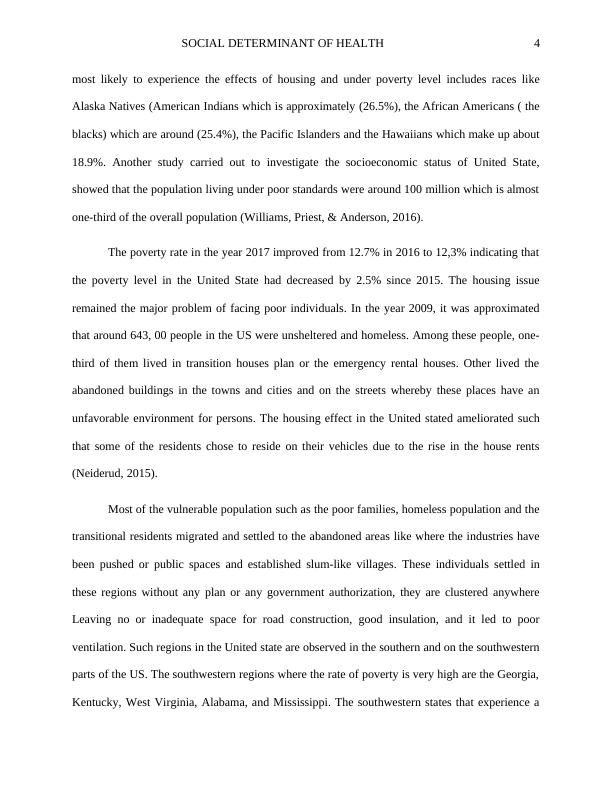Social Determinant of Health: Housing and Its Impact on Low-Income Families in the US
14 Pages4137 Words246 Views
Added on 2022-11-17
About This Document
This essay discusses the impact of housing as a social determinant of health on low-income families in the US. It analyzes the ways in which housing influences health status and how to improve the standards of living among the affected population.
Social Determinant of Health: Housing and Its Impact on Low-Income Families in the US
Added on 2022-11-17
ShareRelated Documents
Running head: SOCIAL DETERMINANT OF HEALTH 1
Housing
Student’s Name
Professor’s Name
Institution Affiliation
Date
Housing
Student’s Name
Professor’s Name
Institution Affiliation
Date

SOCIAL DETERMINANT OF HEALTH 2
Introduction
The social determinants of health (SDH) involve the quality measure which examines the
status and existence of health, health care accessibility and the presence of equity and inequities
in the provision of quality healthcare services. The Department of Human and Health Services
(DHHS) in United State (US) is the one accountable in determining social inequities in disease,
mortality, development strategies and health inequalities for the US population which are likely
to experience health risk such as poor environment based within the minority ethnic groups,
socioeconomic status, urban or rural residents and housing status. In the studies to examine the
inequalities of the social determinant of health, the DHHS focuses on housing condition,
nutrition, pregnancy status in women, the impact of poverty, sanitation and infant mortality rate
in the United State. The social determinants of health can be described as the living conditions or
the social surroundings in which people are live, work, born and the playing grounds especially
during childhood. These factors have significant effects on the quality of an individual’s
lifestyle, health risk, body functioning, and development. The family background gives person
sustainability that is helpful in life such as effective parental skills, the ideal family environment
and social economic status (Bowen, Bowen & Barman-Adhikari, 2016). This essay demonstrates
how housing as a social determinant of health affects the livelihood of the low-income
population in the US. It will address the issue of housing on families living under the poverty
line in America. In addition, the essay will discuss and analyze the ways in which housing
influence health status and how to improve the standards of living among the affected
population.
Population description
Introduction
The social determinants of health (SDH) involve the quality measure which examines the
status and existence of health, health care accessibility and the presence of equity and inequities
in the provision of quality healthcare services. The Department of Human and Health Services
(DHHS) in United State (US) is the one accountable in determining social inequities in disease,
mortality, development strategies and health inequalities for the US population which are likely
to experience health risk such as poor environment based within the minority ethnic groups,
socioeconomic status, urban or rural residents and housing status. In the studies to examine the
inequalities of the social determinant of health, the DHHS focuses on housing condition,
nutrition, pregnancy status in women, the impact of poverty, sanitation and infant mortality rate
in the United State. The social determinants of health can be described as the living conditions or
the social surroundings in which people are live, work, born and the playing grounds especially
during childhood. These factors have significant effects on the quality of an individual’s
lifestyle, health risk, body functioning, and development. The family background gives person
sustainability that is helpful in life such as effective parental skills, the ideal family environment
and social economic status (Bowen, Bowen & Barman-Adhikari, 2016). This essay demonstrates
how housing as a social determinant of health affects the livelihood of the low-income
population in the US. It will address the issue of housing on families living under the poverty
line in America. In addition, the essay will discuss and analyze the ways in which housing
influence health status and how to improve the standards of living among the affected
population.
Population description

SOCIAL DETERMINANT OF HEALTH 3
Despite that the United state is known as the richest country in the continent, there is
recognization of millions of population comprising of different races which live under the
poverty line. Around 42.1 million of residents which is around 13.5% of the population in the
United State There are several research that has been conducted which marked the occupational
disparities, the socioeconomic status, ethical and racial groups in the life expectancy and
mortality rate in United State (Beckfield, Bambra, Eikemo, Huijts, McNamara, & Wendt, 2015).
The studies identify the population which has limited access to the Nation’s health
services and longer activities. The most vulnerable population in the US that is likely to be
affected by the housing issues in the US have the following characteristics; the low social class,
population, the minor race and ethnic groups, lowly educated people, low- income individuals,
unemployed, the immigrants, the refugees in US, and the people living with the disabilities in
United State. The social determinant at these populations include, high poverty rate, lack of labor
and market structures, socioeconomic deprivation, income inequalities unaffordable housing,
inaccessibility to shopping centers, poor sanitation environments, inaccessibility , good
nutritional and healthy diet, lack of educational facilities and opportunities, poor transportation
and infrastructure, undeveloped built and physical environment, inadequate space, and
inaccessibility to crucial goods and services. This population experiences a shortage of health
professionals, poor welfare services, insecurity in the environments, and risk of diseases
outbreak (de Andrade et al, 2015).
The families and the populations that mostly operate under the poverty level in United
State are commonly found in very remotes areas of US and in urban caters where people are
densely populated which leads to the creation of slums. These include areas where industry had
been previously developed but it was again removed. The unemployment population which is
Despite that the United state is known as the richest country in the continent, there is
recognization of millions of population comprising of different races which live under the
poverty line. Around 42.1 million of residents which is around 13.5% of the population in the
United State There are several research that has been conducted which marked the occupational
disparities, the socioeconomic status, ethical and racial groups in the life expectancy and
mortality rate in United State (Beckfield, Bambra, Eikemo, Huijts, McNamara, & Wendt, 2015).
The studies identify the population which has limited access to the Nation’s health
services and longer activities. The most vulnerable population in the US that is likely to be
affected by the housing issues in the US have the following characteristics; the low social class,
population, the minor race and ethnic groups, lowly educated people, low- income individuals,
unemployed, the immigrants, the refugees in US, and the people living with the disabilities in
United State. The social determinant at these populations include, high poverty rate, lack of labor
and market structures, socioeconomic deprivation, income inequalities unaffordable housing,
inaccessibility to shopping centers, poor sanitation environments, inaccessibility , good
nutritional and healthy diet, lack of educational facilities and opportunities, poor transportation
and infrastructure, undeveloped built and physical environment, inadequate space, and
inaccessibility to crucial goods and services. This population experiences a shortage of health
professionals, poor welfare services, insecurity in the environments, and risk of diseases
outbreak (de Andrade et al, 2015).
The families and the populations that mostly operate under the poverty level in United
State are commonly found in very remotes areas of US and in urban caters where people are
densely populated which leads to the creation of slums. These include areas where industry had
been previously developed but it was again removed. The unemployment population which is

SOCIAL DETERMINANT OF HEALTH 4
most likely to experience the effects of housing and under poverty level includes races like
Alaska Natives (American Indians which is approximately (26.5%), the African Americans ( the
blacks) which are around (25.4%), the Pacific Islanders and the Hawaiians which make up about
18.9%. Another study carried out to investigate the socioeconomic status of United State,
showed that the population living under poor standards were around 100 million which is almost
one-third of the overall population (Williams, Priest, & Anderson, 2016).
The poverty rate in the year 2017 improved from 12.7% in 2016 to 12,3% indicating that
the poverty level in the United State had decreased by 2.5% since 2015. The housing issue
remained the major problem of facing poor individuals. In the year 2009, it was approximated
that around 643, 00 people in the US were unsheltered and homeless. Among these people, one-
third of them lived in transition houses plan or the emergency rental houses. Other lived the
abandoned buildings in the towns and cities and on the streets whereby these places have an
unfavorable environment for persons. The housing effect in the United stated ameliorated such
that some of the residents chose to reside on their vehicles due to the rise in the house rents
(Neiderud, 2015).
Most of the vulnerable population such as the poor families, homeless population and the
transitional residents migrated and settled to the abandoned areas like where the industries have
been pushed or public spaces and established slum-like villages. These individuals settled in
these regions without any plan or any government authorization, they are clustered anywhere
Leaving no or inadequate space for road construction, good insulation, and it led to poor
ventilation. Such regions in the United state are observed in the southern and on the southwestern
parts of the US. The southwestern regions where the rate of poverty is very high are the Georgia,
Kentucky, West Virginia, Alabama, and Mississippi. The southwestern states that experience a
most likely to experience the effects of housing and under poverty level includes races like
Alaska Natives (American Indians which is approximately (26.5%), the African Americans ( the
blacks) which are around (25.4%), the Pacific Islanders and the Hawaiians which make up about
18.9%. Another study carried out to investigate the socioeconomic status of United State,
showed that the population living under poor standards were around 100 million which is almost
one-third of the overall population (Williams, Priest, & Anderson, 2016).
The poverty rate in the year 2017 improved from 12.7% in 2016 to 12,3% indicating that
the poverty level in the United State had decreased by 2.5% since 2015. The housing issue
remained the major problem of facing poor individuals. In the year 2009, it was approximated
that around 643, 00 people in the US were unsheltered and homeless. Among these people, one-
third of them lived in transition houses plan or the emergency rental houses. Other lived the
abandoned buildings in the towns and cities and on the streets whereby these places have an
unfavorable environment for persons. The housing effect in the United stated ameliorated such
that some of the residents chose to reside on their vehicles due to the rise in the house rents
(Neiderud, 2015).
Most of the vulnerable population such as the poor families, homeless population and the
transitional residents migrated and settled to the abandoned areas like where the industries have
been pushed or public spaces and established slum-like villages. These individuals settled in
these regions without any plan or any government authorization, they are clustered anywhere
Leaving no or inadequate space for road construction, good insulation, and it led to poor
ventilation. Such regions in the United state are observed in the southern and on the southwestern
parts of the US. The southwestern regions where the rate of poverty is very high are the Georgia,
Kentucky, West Virginia, Alabama, and Mississippi. The southwestern states that experience a

End of preview
Want to access all the pages? Upload your documents or become a member.
Related Documents
Health Science Sample Assignmentlg...
|8
|2114
|35
Health Inequality and Ethnicitylg...
|11
|2512
|158
African-Americans Infant Mortalitylg...
|9
|2375
|318
Health Inequalities Assignmentlg...
|9
|2159
|106
Social Determinants of Health Assignment pdflg...
|16
|4019
|20
Housing as a Social Determinant of Healthlg...
|15
|4577
|77
